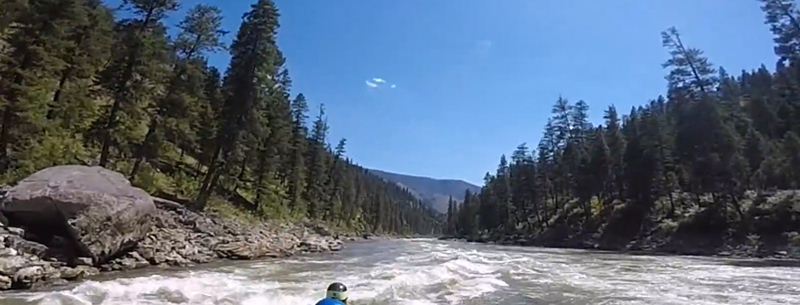Whitewater Rafting in Idaho
Whitewater rafting is simply a blast, pun intended. Whitewater rafting in Idaho is all about the Salmon River.
Idaho is an incredibly beautiful state, a place with no massive cities and the resulting urban sprawl that comes with them. It is a Rocky Mountains state sitting on the border of Canada and part of Yellowstone National Park sits within its boundaries. With so much uninhibited nature, whitewater rafting in Idaho is plentiful and all variety of categories of rapids can be found.
Visualize the boat’s brow cutting through the swirling, surging water; the sun sparkling on the frothy waves, making tiny rainbows; the abrupt lurch of the craft, as the surging waves suddenly shift direction. The adrenalin is pumping, all senses alert, with nature working overtime to orchestrate a thrill you’ll never forget. That’s what most people think a raft trip entails, but there’s much more going on. Your connection with the other rafters forms a matchless adventure that won’t be forgotten.
Salmon River
The Salmon River is located in the central area of Idaho and known as “The River of No Return.” If that doesn’t get your whitewater rafting juices flowing, nothing will!
The Salmon is 425 miles long and drains over 14,000 square miles of land. It drops a whopping 7,000 feet in elevation from its headwaters to its final merger with the Snake River. With an elevation drop like that, you just know the rafting is going to be good.
The top whitewater rafting area is on the middle fork of the Salmon River. The prime area is a 100-mile stretch running through the Frank Church River-of-No-Return wilderness area. This section cuts through the second deepest canyon in North America.
Constriction, elevation drops and plenty of obstructions make the middle fork a top whitewater sport destination. Rapids fall in the category three and four range, making it an adrenaline rush without any serious risk. One and two-day trips can be arranged for the middle fork and there are plenty of whitewater rafting companies offering services. Kayaking is also excellent.
Whitewater rafting in Idaho is a blast, particularly on the Salmon River. Keep in mind it is a popular destination with over 10,000 people giving it a go each year. Enjoy!
Make Memories that Don’t Fade
Scientists have discovered that the intensity of an emotional experience permanently alters the way a person remembers it. Emotionally charged experiences are filed differently in the brain than everyday ones are. Later, they’re recalled with vivid detail, without losing clarity over time. Recalling even a small part of the event brings the full force of experience back. That’s why they’re called “flashbulb memories.”
When people go through such powerful experiences together, they relate to each other in new ways. It’s certainly a step away from their day-in, day-out routines. That’s a major reason why a wilderness adventure like whitewater rafting does more for those who take the trip than a casual vacation would. They develop new ways to relate to nature and each other. Rafters tell me they arranged the trip to get away from the TV and the cell phone. But they’re pleased to find that the river is the tonic for much of what’s stressful for them.
Even when they get home, those newly-forged ways of relating influence the way people treat each other. As the owner for Four Corners Rafting, one of the oldest whitewater rafting company on the Arkansas River, I’ve taken thousands of people on the outdoor adventure. Without exception, they find the experience delivered in ways that they hadn’t expected. I’m often told that what they experienced during whitewater rafting was the highlight of their vacation.” We visited all the other attractions, we saw all the sights. Nothing comes close!”
Step Out of Your Shoes
The benefits that rafters receive don’t stop when the trip is over. We’ve all heard the phrase about walking a mile in someone else’s shoes. That does help to understand the experiences of others with fresh awareness. But I think that greater value comes in understanding yourself better. To step into someone else’s shoes, you must temporarily step out of your own. That breaks a lot of habits and familiar assumptions. Then when you return to your own shoes, you can see aspects of your life that you usually overlook because they’re so unbroken.
Taking a wilderness adventure is a walk in another pair of shoes. And those people who shared that intensely emotional adventure with you took the same mind-stretching trek. That stays with you for the long haul.
